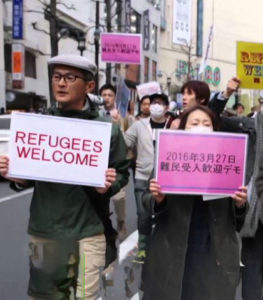Japan opening door to more refugees
Japan will consider accepting more refugees from other Asian countries by 2020, the government has announced.
The Japanese government said it would consider doubling its annual intake of about 30 people having come under pressure from the UNHCR and other humanitarian agencies to do more to address regional humanitarian crises.
Japan will review its current policy of receiving refugees only from Myanmar under the third-country resettlement program led by the UNHCR, the United Nations refugee agency, while promoting their settlement not only in Tokyo and surrounding areas but in other parts of the country, according to the sources.
Tokyo will discuss the idea with UN High Commissioner for Refugees Filippo Grandi, who is visiting Japan this month.
Since 2010 under the third-country resettlement program, Japan has accepted a total of 174 Myanmar refugees, or 44 families, including some Rohingya Muslims, from the western Rakhine State, who had been persecuted and moved to neighbouring Thailand and Malaysia.
Japan is known for its tight immigration policy. In 2017, the country accepted only 20 of about 20,000 people who applied for refugee status, and allowed only 45 to stay in the country on humanitarian grounds, according to the Justice Ministry.
Japan’s acceptance of refugees has been conducted in line with the UN convention governing refugees, as well as with the third-country resettlement program.
The refugees accepted under the current resettlement program stay for about six months in Tokyo to learn the Japanese language and then move to areas where they will settle.
The Japanese government is also considering starting to accept refugees twice a year, an increase from the current annual intake.
It is also considering accepting refugees from countries other than those from Myanmar, but arrangements on which nationalities have not yet been finalised.
In May last year, the Japanese government began encouraging refugees to live in rural areas that are facing a decline in population.
Many of the refugees who have come to Japan in recent years have settled in the regional prefectures of Saitama, Chiba and Kanagawa.
The review of Japan’s refugee program is expected to accelerate refugee resettlement in rural areas, with a Foreign Ministry official saying the government is “actively studying” the possibility of selecting areas other than the Tokyo metropolitan region.
Candidate sites will be assessed based on whether there are jobs for refugees, accommodation that matches their income and an environment to learn the Japanese language.
But some critics say that assistance following the resettlement is not adequate.
The move comes as Japan also plans to accept more foreign workers by setting up a new residence status for those working in sectors deemed to be short of labour, such as nursing and construction, as the country struggles with a rapidly greying population and low birth rate.
But some critics say the plan to accept more foreign workers is a way to import cheap labour, given that foreigners from developing countries, who receive on-the-job training under government programs, are often found to have to work in very poor conditions.
Laurie Nowell
AMES Australia Senior Journalist












